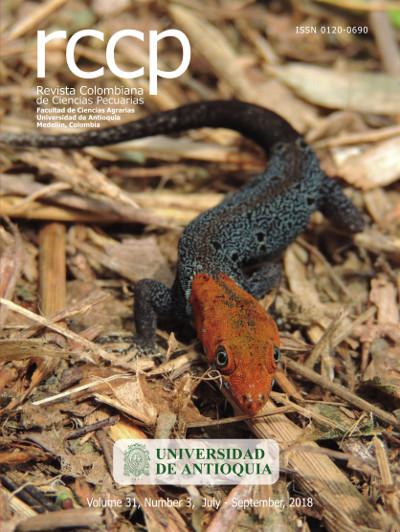Ultrasound diagnosis of lateral digital extensor muscle, tendon, and synovial sheath alterations in Colombian creole horses with clinical signs of tarsus hyperflexion
DOI:
https://doi.org/10.17533/udea.rccp.v31n3a03Keywords:
equine, hock hyperflexion, locomotion, mechanical claudication, stenosing tenosynovitisAbstract
Background: Tarsus hyperflexion alters locomotion biomechanics in horses. This alteration is of frequent presentation in the Colombian creole horse (CCH). Objective: To determine the echographic alterations of lateral digital extensor (LDE) muscle, tendon, and synovial sheath in CCH with clinical signs of tarsus hyperflexion. Methods: Thirty horses were divided into two groups: 15 healthy horses with no history of locomotion defects (Group 1; control), and 15 horses with clinical signs of tarsus hyperflexion (Group 2). A cross-sectional and a longitudinal echocardiographic examination of the LDE muscle and tendon was performed in all horses, and a histopathological study was performed only to Group 2. Results: 86.7% of the horses showed echographic alterations, with 53.4% showing signs of adhesions in the LDE muscle and tendon in the lateral surface of the hock, where it crosses the tarsus. 33.3% presented increased tendon sinovial sheath fluid. 13.3% showed no echographic alterations and 53.3% presented histopathological alterations. Conclusion: These findings may be related to the presentation of tarsus hyperflexion that could characterize the classic stringhalt in CCH.
Downloads
References
Araujo JAS, Curcio B, Alda J, Medeiros RM, Riet-Correa F. Stringhalt in Brazilian horses caused by Hypochaeris radicata. Toxicon 2008; 52(1):190-193.
Araya O, Krause A, Solís de Ovando R. Outbreaks of stringhalt in southern Chile. Vet Rec 1998; 142(17):462-263.
Armengou L, Añor S, Climent F, Shelton GD, Monreal L. Ante-morten diangosis of a distal axonopatia causing severe stringhalt in a horse. J Vet Intern Med 2010; 24(1):220-223.
Boswell JC, Schramme MC. Desmitis of the accessory ligament of the deep digital flexor tendon in the hindlimb in a horse. Equine Vet Educ 2000; 12(3):129-132.
Cahill JI, Goulden BE, Pearce HG. A review and some observations on stringhalt. N Z Vet J 1985; 33(7):101-104.
Crabill MR, Honnas CM, Taylor DS, Shumacher J, Watkins JP, Snyder JR. Stringhalt secondary to trauma to the dorsoproximal region of the metatarsus in horses: 10 cases (1986-1991). J Am Vet Med Assoc 1994; 205(6):867-869.
Dik KJ. Ultrasonography of the equine tarsus. Vet Radiol 1993; 34(1):36-43.
Domange C, Casteignau A, Collignon G, Pumarola M, Prymenko N. Longitudinal study of Australian stringhalt cases in France. J Anim Physiol Anim Nutr 2010; 94(6):712-720.
Duque D, Velasquez V, Espinoza L, Arias MP. Idiophatic stringhalt in a Colombian creole horse. Rev Colomb Cienc Pecu 2014; 27(3):227-233.
Garret KS. Ultrasonography of the hock. In: Kidd JÁ, Lu KG, Frazer ML. Atlas of equine ultrasonography. Oxford UK: Jhon Wiley & Sons, Ltd; 2014. p.149-159.
Huntington PJ, Jeffcott LB, Friend SC, Luff AR, Finkelstein DI, Flynn RJ. Australian Stringhalt-epidemiological, clinical and neurological investigations. Equine Vet J 1989; 21(4):266-273.
Martínez JR, Resende FR, Silveira AGE. Considerações sobre a claudicação mecânica caracterizada por hiperflexão do tarso -Arpejamento-. Braz J Equin Med 2007; 2(14):22-24.
Oliver OJ, Suarez JC. An outbreak of Australian stringhalt associated with skin lesions in Colombia. Rev Colomb Cienc Pecu 2016; 29(3):226-234.
Pennington N, Colles C, Dauncey E. Australian stringhalt in the UK. Vet Rec 2011; 169(18):476.
Reef VB. Equine diagnostic ultrasound. Philadelphia PA: Saunders. 1998. p. 560.
Stashak TS. Stringhalt. In: Stashak T.S. Ed. Adam’s Lameness in Horses. 4th ed. Philadelphia: Lea & Febiger. 1987. p.723-725.
Stashak TS. 2004. Arpeo. En: Adams: Claudicación en el caballo.5ª ed. Inter-médica. p.1058.
Sullins KE. Stringhalt. In: Stashak T.S. Ed. Adam’s Lameness in Horses. 5th ed. Philadelphia; 2002. p. 983-985.
Torre F. Clinical diagnosis and results of surgical treatment of 13 cases of acquired bilateral stringhalt (1991-2003). Equine Vet J 2010; 37(2):181-183.
Valentine BA. 2003. Mechanical lameness in the hindlimb. In: Ross M.W; Dyson, S.J. Eds. Diagnosis and management of lameness in the horse. Philadelphia: Saunders. p. 475-480.
Whitcomb MB. Ultrasonography of the Equine Tarsus. In: Proceedings of the 52nd Annual Convention of the American Association of Equine Practitioners (AAEP), San Antonio, Texas, USA, December 2-6, 2006.
Wood AK, Newell WH, Borg RP. An ultrasonographic off-set system for examination of equine tendons and ligaments. Am J Vet Res 1991; 52(12):1945-1947.
Downloads
Published
How to Cite
Issue
Section
License
Copyright (c) 2017 Revista Colombiana de Ciencias Pecuarias

This work is licensed under a Creative Commons Attribution-NonCommercial-ShareAlike 4.0 International License.
The authors enable RCCP to reprint the material published in it.
The journal allows the author(s) to hold the copyright without restrictions, and will allow the author(s) to retain publishing rights without restrictions.






